Tracking the DIY phenomenon Part 2: Mass customization, mashups, and recombinant Web apps, by Dion Hinchcliffe

Images and text source: ZDnet
February 25th, 2007
In my last post, I took a look at the recent proliferation of Web widgets, which are modular content and services that are making it easier for anyone to help themselves to the vast pool of high value functionality and information that resides on the Web today. Companies are actively “widgetizing” their online offerings so that it can actively be repurposed into other sites and online products. And as we discussed in the last post, it’s believed that letting users innovate with your online offerings by letting embedding them in their own Web sites, blogs, and applications can greatly broaden distribution and reach, leverage rapid viral propagation over the Internet, and fully exploit the raw creativity that theoretically lies in great quantities on the edge of our networks.
DIY on the Web is looking to be a major trend; Newsweek recently speculated that 2007 will be the Year of the Widget.
Looked at this way, letting thousands and even millions of users build Web sites and apps out of your Web parts and then monetizing it with advertising, usage fees, or subscriptions sounds great in the abstract. But one of the big outstanding questions is if widgitizing is mostly useful for gaining fast user adoption and market share, and not for building the fundamentals of a viable, long-term business online. While this last question is still very much an open one, part of the answer will come from the way that the consumption side of DIY develops. The question is this: Are environments emerging that will enable rich and sophisticated DIY scenarios that are usable by most people?











